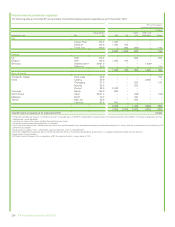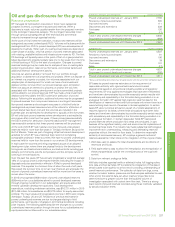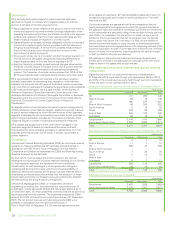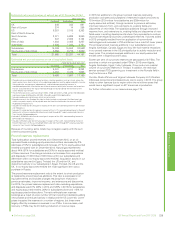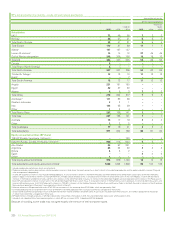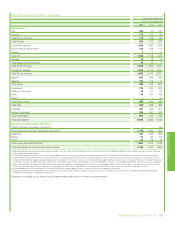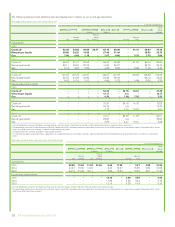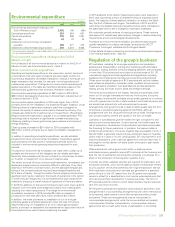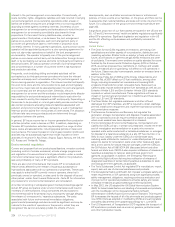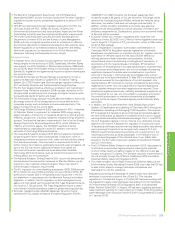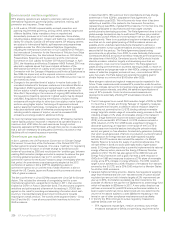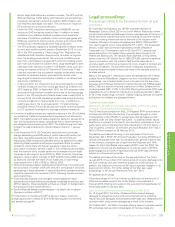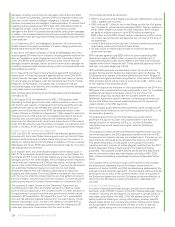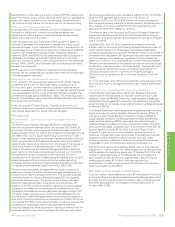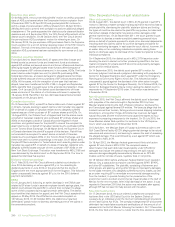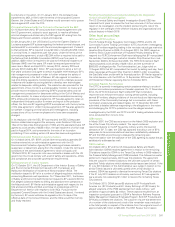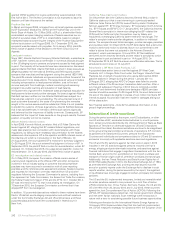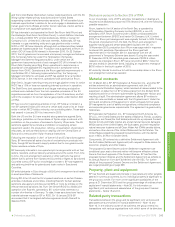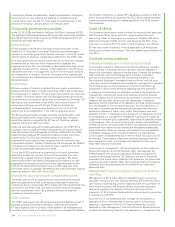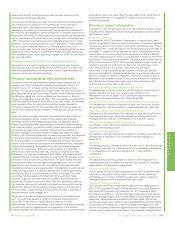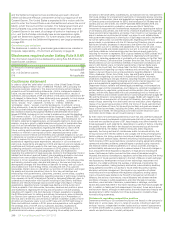BP 2015 Annual Report Download - page 240
Download and view the complete annual report
Please find page 240 of the 2015 BP annual report below. You can navigate through the pages in the report by either clicking on the pages listed below, or by using the keyword search tool below to find specific information within the annual report.
Environmental maritime regulations
BP’s shipping operations are subject to extensive national and
international regulations governing liability, operations, training, spill
prevention and insurance. These include:
• In US waters, OPA 90 imposes liability and spill prevention and
planning requirements governing, among others, tankers, barges and
offshore facilities. It also mandates a levy on imported and
domestically produced oil to fund oil spill responses. Some states,
including Alaska, Washington, Oregon and California, impose additional
liability for oil spills. Outside US territorial waters, BP shipping tankers
are subject to international liability, spill response and preparedness
regulations under the UN’s International Maritime Organization,
including the International Convention on Civil Liability for Oil Pollution,
the International Convention for the Prevention of Pollution from Ships
(MARPOL) Convention, the International Convention on Oil Pollution,
Preparedness, Response and Co-operation and the International
Convention on Civil Liability for Bunker Oil Pollution Damage. In April
2010, the Hazardous and Noxious Substance (HNS) Protocol 2010 was
adopted to address issues that have inhibited ratification of the
International Convention on Liability and Compensation for Damage in
Connection with the Carriage of Hazardous and Noxious Substances by
Sea 1996. As at year end, as the required minimum number of
contracting states had not been achieved, the HNS Convention has not
yet entered into force.
• Changes to the permitted level of sulphur in marine fuels under EU
mandated reductions for European waters and International Maritime
Organization (IMO) regulations are being phased in until 2020, when
the low sulphur rules for shipping in global waters are scheduled to
take effect. Depending on the outcome of ongoing IMO deliberations,
the regulations impacting operations in global waters may be delayed
until 2025. Regulations requiring the reduction of sulphur oxides
emissions will require ships to either burn low sulphur marine fuels or
continue using higher sulphur fuel along with approved on-board
sulphur abatement technology. Compliance with the IMO regulations
may place additional costs on refineries producing marine fuel,
including costs to dispose of sulphur, as well as increased GHG
emissions and energy costs for additional refining.
To meet its financial responsibility requirements, BP shipping maintains
marine liability pollution insurance in respect of its operated ships to a
maximum limit of $1 billion for each occurrence through mutual
insurance associations (P&I Clubs), although there can be no assurance
that a spill will necessarily be adequately covered by insurance or that
liabilities will not exceed insurance recoveries.
Greenhouse gas regulation
In 2011, parties to the UN Framework Convention on Climate Change
(Framework Convention) at the Conference of the Parties (COP17) in
Durban agreed to several measures. One was a ‘roadmap’ for negotiating
a legal framework for action on climate change by 2015 that would
involve all countries by 2020 and would close the ‘ambition gap’ between
existing GHG reduction pledges and what is required to achieve the goal
of limiting global temperature rise to 2°C. Another was a second
commitment period for the Kyoto Protocol to begin immediately after the
first period. An amendment was subsequently adopted at the 2012
conference of parties in Doha (COP18) establishing a second
commitment period to run until the end of 2020. However, it did not
include the US, Canada, Japan and Russia and thus covers only about
15% of global emissions.
The 2014 conference in Lima (COP20) adopted the Lima Call for Climate
Action. This included the elements of a negotiating text for a new
international agreement, as specified in Durban in 2011, that would be
finalized at COP21 in Paris in December 2015. This text covers long-term
ambitions and pathways and a framework for reaching it. COP20 also
agreed on the rules for providing and assessing information about each
country’s ’Intended Nationally Determined Contributions’ towards
reaching the overall ambition. The world’s three largest emitters – China,
the US and the EU – have all announced their intentions to limit their
GHG emissions.
In December 2015, 195 nations at the United Nations climate change
conference in Paris (COP21) adopted the Paris Agreement, for
implementation post-2020. This will come into force when it has been
ratified by at least 55 of the parties to the Framework Convention,
representing at least 55% of global GHG emissions. For the first time this
binds all participants to its provisions and encourages voluntary
contributions by developing countries. The Paris Agreement aims to hold
global average temperature rise to well below 2oC above pre-industrial
levels and to pursue efforts to limit temperature rise to 1.5oC above pre-
industrial levels. There is no quantitative long-term emissions goal but
countries aim to reach global peaking of GHG emissions as soon as
possible and to undertake rapid reductions thereafter to achieve a
balance between human caused emissions and natural absorption in the
second half of this century. The Paris Agreement places binding
commitments on all parties, from 2020, to make Nationally Determined
Contributions (NDCs) and pursue domestic measures aimed at achieving
the objectives of their NDCs. Developed country NDCs should include
absolute emission reduction targets, and developing countries are
encouraged to move over time towards them. The Paris Agreement
places binding commitments on countries, starting by 2023, to report on
their emissions and progress made on their NDCs; undergo international
review of collective progress; and submit new, more ambitious NDCs
every five years. The Paris Agreement extends the existing goal for
climate finance to a minimum of $100 billion after 2025.
More stringent national and regional measures can be expected in the
future. These measures could increase BP’s production costs for certain
products, increase demand for competing energy alternatives or products
with lower-carbon intensity, and affect the sales and specifications of
many of BP’s products. Current and announced measures and
developments potentially affecting BP’s businesses include the
following:
• The EU has agreed to an overall GHG reduction target of 20% by 2020.
To meet this, a ‘Climate and Energy Package’ of regulatory measures
was adopted that includes: a collective national reduction target for
emissions not covered by the EU ETS; binding national renewable
energy targets to double usage of renewable energy sources in the EU
including at least a 10% share of renewable energy in the transport
sector; a legal framework to promote carbon capture and storage
(CCS); and a revised EU ETS Phase 3. EU ETS revisions included a
GHG reduction of 21% from 2005 levels; a significant increase in
allowance auctioning; an expansion in the scope of the EU ETS to
encompass more industrial sectors (including the petrochemicals
sector) and gases; no free allocation for electricity generation (including
that which is self-generated off-shore) or production, but benchmarked
free allocation for energy-intensive and trade-exposed industrial
sectors. EU ETS revisions also included the adoption of a Market
Stability Reserve to reduce the supply of auctioned allowances. This
will take effect in 2019 and could potentially lead to higher carbon
costs. EU Energy efficiency policy is currently implemented via national
energy efficiency action plans and the Energy Efficiency Directive
adopted in 2012. The EU has also agreed to the 2030 Climate and
Energy Policy framework with a goal of at least a 40% reduction in
GHGs from 1990 and measures to achieve a 27% share of renewable
energy and a 27% increase in energy efficiency. The GHG reduction
target is to be achieved by a 43% reduction of emissions from sectors
covered by the EU ETS, and a 30% GHG reduction by Member States
for all other GHG emissions.
• Canada’s highest emitting province, Alberta, has regulations targeting
large final emitters (sites with over 100,000 tonnes of carbon dioxide
equivalent per annum) with intensity targets of 2% improvement per
year up to 20%. Compliance is possible via direct reductions, the
purchase of offsets or the payment of C$20/tonne to a technology fund
which will escalate to $30/tonne in 2017. A new policy direction has
just been announced for post-2018 where performance relative to a
best in sector benchmark (to be determined) will now determine the
volume of emissions subject to a cost ($30/tonne escalating in real
terms) or use of other compliance mechanisms such as offsets.
• In the US, the EPA continues to pursue regulatory measures to
address GHGs under the CAA.
– EPA regulations impose light, medium and heavy duty vehicle
emissions standards for GHGs and permitting requirements for
236 BP Annual Report and Form 20-F 2015


